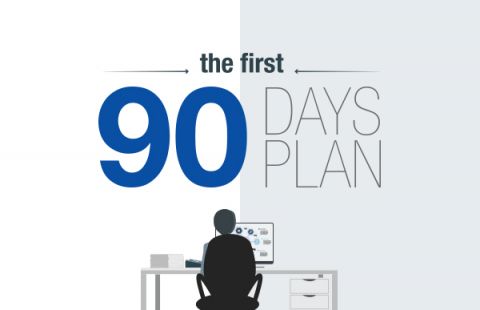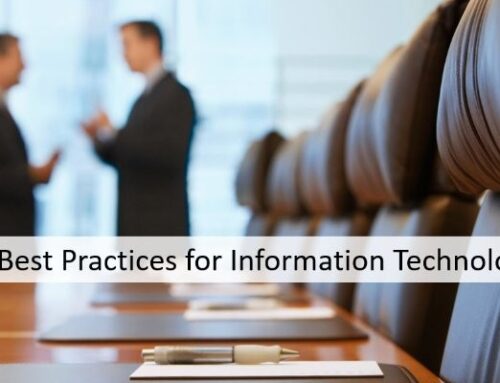Having a proven and methodical plan for your first 90 days in a new IT leadership role is critical for establishing trust, credibility, and alignment between IT and the business.
What are some mistakes that are often made in the first 90 days?
- Getting too busy fighting fires, not understanding the business well enough and establishing relationships.
- Failure to establish some trust and credibility.
- Telling people what has been done before and should work here too. Not listening to what is being said because you think you’ve heard it all before, many times.
- Senior management fails to adequately support IT leadership.
- No measures of what success will look like in 90 days, six months or one year from initial hire.
What does a good 30 60 90 day plan look like?
- It starts with a clear definition of objectives that are rooted in value to the company.
- It identifies specific deliverables and aligns them back to the objectives.
- It contains discrete themes for each plan stage (e.g. 30 – audit, 60 – process, 90 – program)
- It provides a clear set of tasks with dates.
90 Plan Reality
Real world leadership has taught me that in some scenarios it can take up to four to six months to complete this process thoroughly in complex and culturally challenging environments. There have been numerous instances where I’ve led IT and there are no systems inventories, very little process documentation, no BCP/DRP, no KPIs, no metrics, no alignment strategy, and an immense need for IT to solve major business pains and re-establish trust and credibility after years of distant and dis-engaged IT leadership. I’ve had to find ways to get quick wins and credibility for the business to only begin to be able to begin to have conversations about strategy, projects and supporting business metrics. Some cultures can have HUGE barriers to success for IT leaders but we must leverage our political savvy, relationship management, problem solving, and intellectual horsepower to get past roadblocks to support the business.
Plan Example
Please feel to read through the example plan below and download for your use. You can relieve detail to make it more simpler or add more detail for interview presentations. It is easily customizable for any senior head of IT leadership position.
I would expect any CEO, CFO, COO or CHRO to have potential IT leadership candidates to be able to physically provide an example plan for interviews and show what specific results the plan has accomplished in the past.
I have used this successfully as head of IT and as a consultant to drive award winning IT transformation and growth in numerous organizations.
https://www.slideshare.net/brucemccullough/cio-first-90-days-plan-example?ref=
Plan Outline Example – Text Version
The following is the basic outline of the Power Point Plan noted above.
Outline
- Introduction
- Overview
- Primary Goals
- Where do we focus?
- Functional Focus Areas
- Frameworks & Methodologies
- Assessment Over Examples
- Time Line
- First 30 Days
- 30-60 Days
- 60-90 Days
- Summary
Introduction: Overview
To ensure that the IT services provided to an organization are fit for purpose and fit for use, it is imperative that we consider 4 key areas that include: People, Products, Processes and Partners. The four P’s are addressed over 3 stages of the first 90 days.
Introduction: Primary Goals
- Understand the company goals and associated IT expectations.
- Set the stage to become fully accountable for technology operations.
- Assess the IT team’s ability to drive innovation, fuel growth, enable change, and create competitive advantage.
- Identify stakeholders needs, expectations, and communication methods.
- Adapt to the company culture and build relationships.
- Define, prioritize, and agree on key personal and team objectives early.
- Listen, learn, engage and communicate at all levels of the business.
- Examine fiscal requirements and vendor relationships.
- Evaluate IT organizational structure and performance leveraging proven industry best practices, frameworks, and methodologies.
- Capture critical core business processes, metrics, and KPIs.
- Look for quick wins with maximum business impact with no interruption.
- Get a solid understanding of the history and why decisions have been made.
- Thoroughly document the environment, analysis, and recommendations.
- Secure early wins to build trust, confidence, and commitment.
- Develop an initial business-aligned IT strategy and road map.
Where do we focus?
How do assess the environment?
Frameworks & Methodologies
- ITIL Service Operations
- Six Sigma Processes
- COBIT Governance
- SAN, NIST Security
- PMI PMBOK
- CMMI SW Development
- ISO 27031 DRP
- Gartner Benchmarks
- GAAP IT Spending
- ISO 30400 Series HR
- IT Strategy Health Check
- SWOT Analysis
- Performance Scorecard
- Quick-Hits and wins
- Good Manufacturing Practice
* Initial assessments will based on “light” versions
Assessment Example: COBIT
Assessment Example: ITIL
IT Strategy and Roadmap Approach
Timeline – First 30 Days, 30-60 Days, 60-90 Days
Timeline: First 30 Days (Phase 1)
The first 30 days emphasizes high level conversations and getting to know the new organization and role. The focus should be on meeting with executives, stakeholders, and technology staff, while understanding the business, most critical processes, building relationships, and collecting documentation.
Technology Staff Assessment
- Hold group introduction meeting.
- Gather existing performance reviews & resumes.
- Which relationships are strong or weak (internal or external)?
- What conflicts or issues exist?
- Understand roles, responsibilities, and measurements of each individual and team.
- Perform one on one meetings.
- What is their current level of utilization and capacity?
- Assess strengths, weakness, opportunities, threats.
- What road blocks does the team and individuals have?
- What training, coaching, and mentoring is needed?
Executives and Stakeholders Engagement
- What has worked well and what has not from IT?
- What are the most urgent IT issues?
- What pains, wants, and needs do they have?
- What are their key processes, metrics, and KPIs?
- Discuss financial reporting, procedure to pay, order to cash, GRC, audit, security, leasing, capital expenditure with the CFO.
- Meet with supply chain manufacturing and distribution for walk throughs. Discuss scheduling, QA, trackability, waste, EDI, 3PL, ERP, WMS, labeling, printing, scanning, kiosks, time clocks, access control, security cameras, AP/AC processing, and supplier portal.
- Review with Human Resources: HR systems, employee entrance/exit, MACD, benefits, training, compensation, compliance, employee administration, payroll and reporting.
- Interview Head of Marketing and Sales. Discuss CRM, remote access, mobility, IT help desk, laptops, document processing, collaboration, social media, web commerce.
- Meet with COO to get history and political landscape. Discuss priorities, means of communications, expectations, level of independence, metrics, etc.
Infrastructure Assessment
- Security, patching, scalability, performance, cost effectiveness, manageability, scalability, reliability, supportability.
- Architecture, network, telecommunications, EDI, storage, servers, hosting, workstations, mobility, WIFI.
Applications Inventory and Lifecycle Review
- Entire portfolio with strong focus on SAP, Salesforce, WMS, and collaboration.
Service Delivery and Support Review
- Overview of all (metrics, KPIs, SLAs, pricing).
- Collect outsourcing and software maintenance contracts.
- Support, maintenance and project management.
- ITIL light service assessment and quick win recommendations.
- Perform light version assessments of security, vendors, COBIT, PMI PMBOK.
- Review Business Impact Analysis and IT Disaster Recovery Plans.
Budget Review
- High level benchmarking.
Strategic Planning
- Review technology planning process and perform SWOT.
Timeline: End of 30 Days (Phase 1)
Actions
- Major IT Vendors and Suppliers – Hold Meetings
- Hold one on one with IT team and COO to review first 30 day understanding, progress, and clarify any wrong information.
- Discuss objectives for 30-60 days.
- Agree on individual actions for the next 30 days.
- Set up meeting schedules.
- Assign action items due dates.
- Continue daily ongoing IT operations service review or adjust based upon availability and demand.
Deliverables
- Documented interview and assessment findings.
- List of current pain points, challenges, and projects.
- Organization chart.
- Create IT document repository and access portal.
- Build IT services portal for senior management.
- Email to all employees announcing on boarding from COO.
Timeline: 30-60 Days (Phase 2)
The 30-60 days emphasizes continued conversations with organization leaders and getting to know more of the Technology team. There is an increased emphasis on drilling down deeper into the IT portfolio, documentation, and services.
Major Themes:
- Continue meeting as many people as possible.
- Study the products and collected documentation in more detail.
- Document and structure feedback on findings.
- Continue IT operations daily meetings or as need to stay on top of things.
By the end of the 60 days, we should have a good idea for the state of the environment at a semi deep level.
Infrastructure Assessment
- Deeper drill down security, patching, scalability, performance, cost effectiveness, manageability, scalability, reliability, supportability.
- Deeper drill down architecture, network, telecommunications, EDI, storage, servers, hosting, workstations, mobility, WIFI.
Applications Inventory and Lifecycle Review
- Entire portfolio with strong focus on SAP, Salesforce.
Service Delivery and Support Review
- Overview of all (metrics, KPIs, SLAs, pricing).
- Collect outsourcing and software maintenance contracts.
- Support, maintenance and project management.
- 2nd stage ITIL service assessment.
- 2nd stage assessments of security, vendors, COBIT, PMI PMBOK.
- 2nd stage review Business Impact Analysis and IT Disaster Recovery Plans.
Budget Review
- Follow-ups from initial review.
Strategic Planning
- Perform any follow-ups from stage 1.
Business Lieutenants
- Meet with Directors, Managers and ask same questions as executives.
- Technology Staff
- Any remaining as possible and same questions where applicable.
- Smaller Consultants and Contractors
- Get insights, feedback, plans.
Timeline: End of First 60 Days
Actions
- Document findings and place into repository.
- Hold one on one with IT team and COO to review first 60 day understanding, progress, and clarify any wrong information.
- Discuss objectives for 60-90 days.
- Agree on individual actions for the next 30 days.
- Set up meeting schedules.
- Assign action items due dates.
- Continue daily ongoing IT operations service review or adjust based upon availability and demand.
Deliverables
- Initial assessment findings and review presentation from frameworks and methodologies.
- Celebration of any initial wins with the COO and IT team.
- Begin to build relationships and commitment from the IT team.
Timeline: 60-90 Days (Phase 3)
In the last 30 days we establish recurring conversations to leverage the knowledge gathered to begin development.
Major Themes:
- Recurring meetings
- Expanding network internally and with vendors
- Validating plans with leadership
By the end of the 90 days, we have a solid understanding of the first year action plan. We will need to validate these plans with leadership across the organization and validate before execution. We’ll start contacting larger external partners and begin thinking about longer-term strategic plans.
Executives
- Establish recurring update / meeting schedule
Technology Staff
- Establish recurring update / meeting schedule
- Initial meetings with all remaining, as possible
- Same questions, where applicable
Major Vendors / Partners
- Leverage knowledge from previous conversations
- What has gone well, what has not
- Thoughts on pricing, contracts, future needs
Infrastructure
- Network & Telecommunications
- Telecommunication contracts review
- Servers & Hosting
- Hosting / Co-Lo / SaaS providers – contracts, performance tracking
- Capacity forecasting
- Workstation Environment
- Capacity forecasting
Applications
- Standards (languages, vendors, disk capacity)
- Back Office Suite Details (Integration, capacity, forecasting)
- License audit / tracking
Services
- Details of any remaining
- Capacity forecasts
- Policies
Budget
- Gap Analysis
Project Intake (IT)
- Pending Projects
Strategic Planning
- Business
Change Management
Support
- SLAs – External Tracking
- Vendors
ITIL / Best Practices Compliance
Timeline: End of First 90 Days
Actions
- Hold one on one with IT team and COO to review first 60 day understanding, progress, and clarify any wrong information.
- Discuss objectives for 60-90 days.
- Agree on individual actions for the next 30 days.
- Set up meeting schedules. Assign action items due dates.
- Continue daily ongoing IT operations service review or adjust based upon availability and demand.
Deliverables
- Present assessment findings and remediation.
- Email to employees with oversight of first 90 days finding, changes in IT services going forward, and commitment to service.
- Completed repository of IT documentation.
- First full cut of IT strategy and roadmap plan.
- Schedule ongoing review of IT strategy and operations with CXOs.
- Established initial trust and credibility.
I would expect any CEO, CFO, COO or CHRO to have potential IT leadership candidates to be able to physically provide an example plan for interviews and show what specific results the plan has accomplished in the past.
I have used this successfully as head of IT to drive award winning IT transformation and growth in numerous organizations.
Thank you for taking the time to read my article. I hope that you find it useful.













